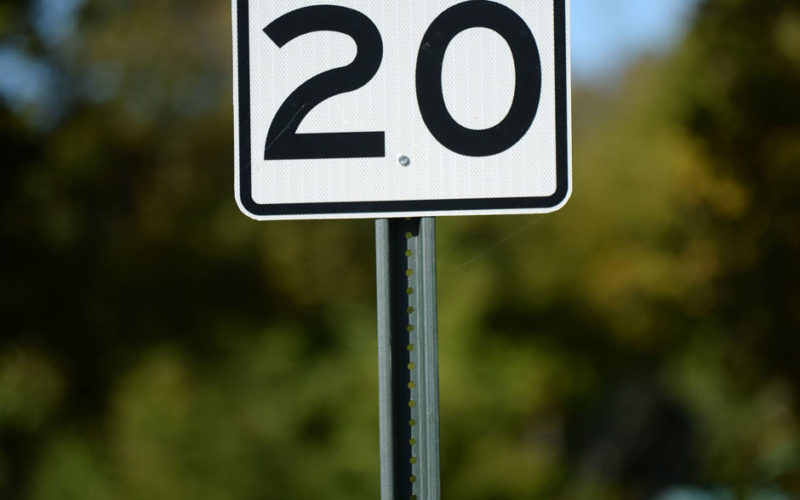City testing lower speed limits in neighborhood
STACY RYBURN
sryburn@nwadg.com
The city of Fayetteville is testing a 20 mph speed limit near Wilson Park and could implement lower speeds for other residential streets.
The 20 mph signs went up Oct. 9. Streets include those with sidewalks and bike routes designated with signs and paint on the asphalt. Those streets are West Prospect Street and East Trenton Boulevard. The mile-long stretch also includes East Rebecca Street past College Avenue to the intersection with North Willow Avenue.
The idea is to make drivers more mindful of bicycles and pedestrians, said Dane Eifling, bicycle programs coordinator with the city. The proposal came out of the resident-led Active Transportation Advisory Committee. The City Council’s Transportation Committee approved the signs last month.
The experiment doesn’t have a set end date. The 20 mph limit may be placed on other residential streets with painted bike routes and sidewalks depending on resident feedback, Eifling said.
The test streets are narrow and have speed tables and on-street parking, which prompt cars to go slower, Eifling said. The 20 mph limit isn’t much different than what drivers already go there, he said. The city measured speeds on Trenton Boulevard from May 28 to June 6 and found the average speed to be about 23 mph.
The area near Wilson Park also has frequent bicycle and pedestrian activity, which makes it a good test site, Eifling said.
“We felt in this instance it’s a very appropriate street to try it out on,” he said. “We’ll try to gauge what, if any, negative feedback we get and what, if any, positive feedback we get.”
Police patrol neighborhoods when they can and set up trailers telling drivers how fast they’re going when appropriate, Chief Mike Reynolds said. Officers go into neighborhoods when they receive complaints about speeding, and oftentimes, their presence alone can serve as a deterrent, he said.
Reynolds said he wasn’t sure about the effectiveness of a 20 mph speed limit. It’s difficult for a car to go slower than 25 mph, he said.
People typically complain because drivers are going excessively fast in their neighborhood, not because they want a lower speed limit, Reynolds said.
“I don’t think in my whole time I’ve ever gotten a complaint from anybody who said we need to lower the speed limit in our neighborhood from 25 to 20 or to 15,” he said. “It seems pretty low to me.”
At least 60% of the city’s streets are residential. The city has about 560 miles of streets, and about 350 of those are residential, according to the city’s street plan. A few other types of street can also serve neighborhoods.
The speed limit by ordinance is 25 mph on residential streets that don’t have signs posted.
Eifling said he understood some neighborhoods would want to keep their 25 mph speed limit. That’s why the city is starting with one target area to where it goes from there, he said.
“We’re dipping a toe in the water of 20 mph speed limits,” Eifling said.
A 2016 ProPublica report shows the exponential risk of death to a pedestrian depending on the speed of a car. The data show a person has a 7% chance of dying if hit by a car going 20 mph and a 12% chance of death if hit by a car going 25 mph. At 30 mph, the risk is 25%.
Paxton Roberts, chairman of the active transportation committee, introduced the idea to his fellow panel members in February. He said lower speed limits in neighborhoods is a growing initiative globally. The practice is recommended by the National Association of City Transportation Officials and the city’s own mobility plan adopted last year.
Lower speed limits alone won’t get drivers to go slower, Roberts said. But also installing traffic-calming features and designing streets to encourage slower speeds will have an effect, he said.
“Ultimately, we need to design slower streets,” Roberts said. “In the meantime, we can do things that make the existing conditions safer. It’s truly like chipping away at a problem.”
Roberts encouraged residents to think about how fast they want cars to go in front of their homes. The active transportation committee will be open to requests for a lower speed limit, he said.
“We’re trying to make these streets safe for everyone, and not just cars,” Roberts said. “That doesn’t mean removing cars. Sometimes it means slowing cars down.”
Portland, Ore., lowered the speed limit to 20 mph for all of its residential streets last year. The city finished replacing the 25 mph signs in April, according to a report from The Oregonian.
Dylan Rivera, spokesman for the Portland Bureau of Transportation, said resident response to the city’s 20 is Plenty campaign has been positive. The city started with placing the 20 mph limit on neighborhood streets with bike routes. The Oregon State Legislature in 2017 allowed the city to lower speed limits on all neighborhood streets, and this year allowed other cities in the state to do the same, he said.
The move is changing the culture of driving in the city, Rivera said.
Fayetteville has been working on different ways to get cars to slow down in neighborhoods, said council member Matthew Petty, who serves as chairman of the Transportation Committee. Methods have included neighborhood-led projects to install makeshift road features, installing more stop signs and encouraging on-street parking. Slower speed limits in some areas could also be part of that equation, he said.
__
20’s Plenty
For more information on the international campaign to lower speed limits in neighborhoods, go to:
20splenty.org






